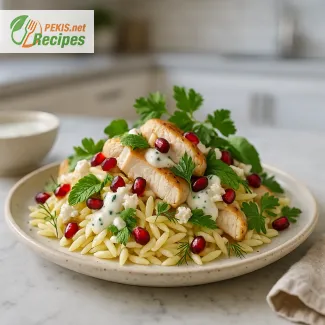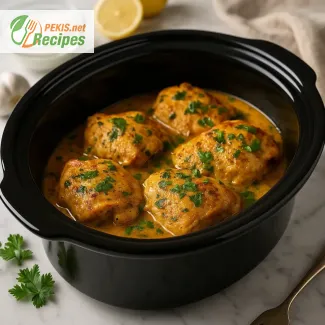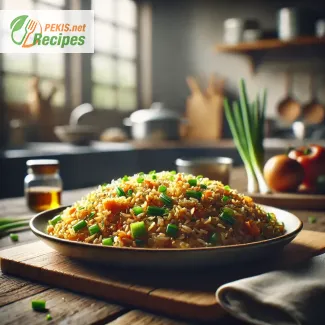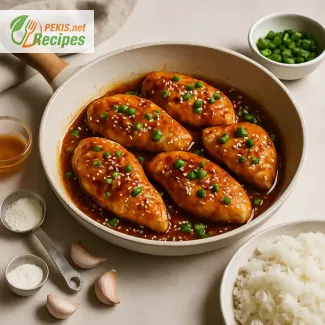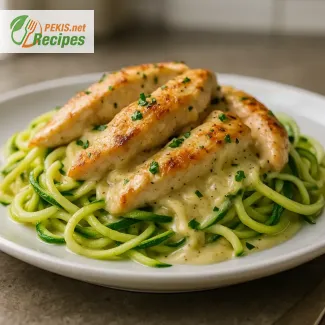
Homemade Comfort: A Traditional Egg Noodle Dish You’ll Love
Discover the rich texture and flavor of homemade egg noodles
There’s something incredibly comforting about a bowl of warm, homemade egg noodles. Whether served as a side dish, tossed in a flavorful stir-fry, or swimming in a rich chicken broth, egg noodles are one of those classic recipes that transcend cultures and generations. They strike the perfect balance between simplicity and satisfaction, offering a soft yet slightly chewy bite that brings warmth and nostalgia to any meal. With just a few pantry staples and a bit of time, you can recreate that traditional taste in your own kitchen—without the need for preservatives or store-bought shortcuts.
Egg noodles have been a staple in home cooking across many countries. From the hand-cut tagliatelle in Italy to the rustic German Spätzle and the delicate Chinese mien, the idea of mixing flour, eggs, and a touch of water to create a versatile noodle is a shared culinary tradition. Yet there’s something distinctively cozy about the version we often associate with American and Central European kitchens: broad, golden ribbons of dough that cook up in minutes and pair beautifully with butter, herbs, sauces, and proteins.
What sets this egg noodle recipe apart is its emphasis on freshness and texture. When you make noodles from scratch, you have full control over the dough—how elastic it is, how thick or thin you roll it, and whether you prefer rustic irregularity or uniform precision. The process is not only easy to learn but also deeply satisfying. Kneading the dough by hand, feeling it come together under your fingers, and watching it transform into smooth sheets ready to be cut and cooked—it’s an experience that reconnects you with the heart of cooking.
In today’s fast-paced world, making homemade egg noodles may seem like a luxury, but the truth is, it’s more accessible than ever. All it takes is a few basic ingredients: flour, eggs, a pinch of salt, and optionally a splash of water or milk to adjust consistency. With just these simple elements, you can create a dough that, once rolled and sliced, cooks in boiling water in just a few minutes. And unlike dried pasta, which can sometimes lose its character, fresh egg noodles offer an unmistakable richness thanks to the yolks, which lend a golden hue and a tender bite.
One of the best aspects of this dish is its adaptability. You can keep it traditional by tossing the noodles with a bit of melted butter and parsley, or take it up a notch with a creamy mushroom sauce, roasted vegetables, or slow-cooked meats. They absorb flavors beautifully and act as a canvas for your culinary creativity. You can even cut them thinner for use in chicken noodle soup or wider for a rustic buttered noodle plate. And if you’re cooking for family or friends, this recipe easily scales up—double the ingredients, and you’ve got enough to feed a crowd.
Another bonus? These noodles can be made ahead and frozen, so you always have a batch ready for a weeknight dinner or a last-minute comfort meal. Just spread the uncooked noodles on a tray, freeze them in a single layer, and then transfer to an airtight container. When needed, they go straight into boiling water—no thawing required.
In terms of pairing, homemade egg noodles go hand-in-hand with slow-braised dishes like beef stew, pot roast, or coq au vin. Their soft, slightly chewy texture is perfect for soaking up rich gravies and savory broths. On the lighter side, they shine in vegetarian dishes with roasted garlic, sautéed greens, or even a simple squeeze of lemon and grated cheese.
And let’s not forget the emotional aspect. There’s something undeniably satisfying about serving a plate of food that you’ve crafted with your own hands from start to finish. It turns a humble meal into an act of care, tradition, and pride.
Whether you're reviving a family recipe or trying something new, these homemade egg noodles will become a beloved addition to your kitchen repertoire. They’re a reminder that sometimes, the best dishes are the simplest ones—made with care, shared with love, and savored one bite at a time.
If you’ve been craving a meal that brings people together with warmth and taste, this egg noodle recipe is the perfect starting point. Stay tuned for the full step-by-step preparation guide, ingredient list, and variations that suit every season and craving.
Step 1: Preparing the dough
Place the all-purpose flour on a clean work surface or in a large bowl. Make a well in the center and crack in the eggs. Add salt and gently beat the eggs with a fork, gradually incorporating the flour from the edges. If the dough feels dry, add a few drops of water. Begin kneading until a smooth, elastic dough forms. This takes about 8–10 minutes. Wrap the dough in plastic wrap and let it rest for 20 minutes at room temperature.
Step 2: Rolling and cutting the noodles
After resting, divide the dough into two pieces. Using a rolling pin or a pasta machine, roll each piece into thin sheets about 1–2 mm (0.04–0.08 inch) thick. Lightly dust with semolina flour to prevent sticking. Roll up the sheets loosely and cut into strips of your desired width (e.g. 6 mm / ¼ inch for wide noodles or 3 mm / ⅛ inch for finer noodles). Unroll the strips and dust again with semolina.
Step 3: Cooking the noodles
Bring a large pot of salted water to a boil. Add the noodles and cook for 2–3 minutes until al dente. Fresh noodles cook much faster than dried pasta. Drain and serve immediately with your choice of sauce, butter, or as a side dish.
Elevating Classic Egg Noodles with Creative Twists
Tips and ideas to enrich flavor, texture, and nutritional value
Homemade egg noodles are beloved for their simplicity, but this humble dish offers ample opportunities for enhancement. From subtle ingredient swaps to flavor-boosting additions and healthier flour alternatives, even the most traditional recipe can become a culinary masterpiece with just a few thoughtful tweaks. Whether you're aiming for richer taste, better texture, or improved nutritional content, experimenting with a few proven ideas can breathe new life into your next batch of egg noodles.
Upgrading the flour: beyond all-purpose
The classic recipe calls for all-purpose flour, which gives the noodles their characteristic softness. However, if you're aiming for a firmer bite or added nutritional value, consider mixing in or replacing part of the flour with alternatives:
- Durum wheat semolina flour brings a firmer, more elastic texture that holds up well in soups or baked pasta dishes. Its higher protein content enhances structure and chewiness.
- Whole wheat flour adds a nuttier flavor and boosts fiber content, though it results in slightly denser noodles. To balance texture, combine it 50:50 with white flour.
- Spelt flour offers a mildly sweet, nutty undertone and is easier to digest for some. It works well for more rustic noodle dishes and provides additional minerals.
- 00 Italian flour creates ultra-smooth and delicate noodles, perfect for light sauces or refined presentations.
Adding flavor directly into the dough
Infusing your noodles with additional ingredients is an easy way to enhance their flavor profile before they ever touch a sauce. Consider kneading the following into your dough:
- Herbs like finely chopped parsley, chives, or basil not only add color but also aromatic freshness.
- Garlic powder or onion powder introduces subtle umami undertones that pair beautifully with cream or mushroom sauces.
- Grated hard cheese, such as Parmesan or Pecorino Romano, lends a salty, nutty note and a richer texture.
- Spinach purée gives the noodles a vibrant green color and adds iron and antioxidants.
These additions make the noodles flavorful enough to stand on their own, even with a drizzle of olive oil or melted butter.
Why homemade is superior to store-bought
The benefits of preparing egg noodles from scratch extend far beyond taste. Homemade noodles have a distinct freshness, with a tender bite and a silky texture that dried varieties simply cannot replicate. You also gain complete control over ingredients, allowing you to:
- Avoid additives, preservatives, and excess sodium.
- Customize the dough's consistency to suit your desired texture.
- Adjust thickness based on intended use—thinner for soups, thicker for hearty ragùs.
Fresh noodles also cook faster and absorb sauces more effectively, enhancing the overall flavor of the finished dish.
Common mistakes and how to avoid them
Even a simple recipe can go awry if you're not careful. Here are a few mistakes to watch out for:
- Too dry or too wet dough: Add liquid slowly and knead thoroughly. The dough should be smooth, not sticky or crumbly.
- Skipping the resting period: Resting the dough allows the gluten to relax, making it easier to roll out and less likely to tear.
- Rolling uneven sheets: Inconsistent thickness leads to uneven cooking. Use a pasta machine or ruler for accuracy.
- Not flouring the noodles properly: If the noodles stick together before cooking, they’ll turn gummy. Use semolina or cornmeal to dust them liberally.
Paying attention to these details will result in consistently excellent noodles every time.
Making it healthier without sacrificing flavor
If you want to lighten the dish, several substitutions can improve the recipe’s nutritional profile:
- Use egg whites instead of whole eggs to reduce cholesterol and fat while maintaining structure.
- Substitute part of the flour with oat flour or chickpea flour for added protein and fiber.
- Incorporate vegetable purées like carrot or beet to add natural sweetness, color, and micronutrients.
- Cook the noodles in vegetable broth instead of water for additional depth and a slight reduction in sodium (if low-sodium broth is used).
These changes not only make the dish healthier but also introduce new layers of flavor and color, which can appeal to both children and adults.
Creative serving suggestions
The beauty of egg noodles lies in their adaptability. Once you’ve mastered the base, consider pairing them with:
- Brown butter and sage for a nutty, aromatic finish.
- Roasted garlic and lemon zest for a fresh Mediterranean feel.
- Caramelized onions and goat cheese for a tangy-sweet contrast.
- Slow-cooked beef ragu for a rich, meaty main dish.
Experimenting with toppings and sauces helps keep the dish exciting and seasonally relevant.
Storage and make-ahead tips
Fresh egg noodles can be made in advance and stored easily:
- Refrigerate uncooked noodles in an airtight container for up to 2 days.
- Freeze them in a single layer on a baking sheet, then transfer to a freezer-safe bag for up to 2 months.
- Dry noodles completely and store in a sealed container in a cool, dry place for several weeks.
This flexibility makes them perfect for meal prep or special occasions when time is short.
Improving a traditional egg noodle recipe doesn’t require complex techniques or exotic ingredients. Small, intentional changes—like selecting the right flour, enhancing the dough with herbs or vegetables, or being mindful during preparation—can significantly elevate the final dish. Embrace these enhancements not just to refine your cooking, but to transform a comforting classic into something deeply personal, nutritious, and unforgettable.
Allergens
- Gluten (from wheat flour)
- Eggs
Allergen substitution tips
- To make the noodles gluten-free, replace all-purpose flour with a gluten-free flour blend that includes xanthan gum or psyllium husk for elasticity.
- For an egg-free version, replace each egg with 45 ml (3 tbsp) water mixed with 7 g (1 tbsp) of ground flaxseed (let sit for 10 minutes before adding).
- Vitamin A: 260 µg – supports vision and immune function
- Vitamin B2 (Riboflavin): 0.4 mg – helps convert food into energy
- Folate (B9): 60 µg – essential for cell function and tissue growth
- Iron: 2.2 mg – contributes to oxygen transport in the blood
- Magnesium: 28 mg – supports nerve and muscle function
- Phosphorus: 130 mg – important for bone and teeth health
- Zinc: 1.1 mg – supports immune response and healing
- Selenium: 20 µg – antioxidant protection and thyroid function
- Lutein & Zeaxanthin: 220 µg – promote eye health and reduce risk of macular degeneration
- Vitamin E: 0.6 mg – protects cells from oxidative stress
- Selenium (as antioxidant): 20 µg – combats oxidative damage and supports immunity
